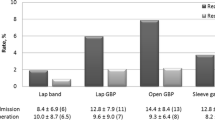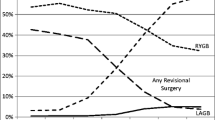Abstract
Introduction
Readmissions are an important quality metric for surgery. Here, we compare characteristics of readmissions across laparoscopic Rouxen-Y gastric bypass (LRYGB), sleeve gastrectomy (LSG), and adjustable gastric band (LAGB).
Methods
Demographic, intraoperative, anthropometric, and laboratory data were prospectively obtained for 1775 patients at a single academic institution. All instances of readmissions within 1 year were recorded. Data were analyzed using STATA, release 12.
Results
For the 1775 patients, 113 (6.37 %) were readmitted. Mean time to readmission was 52.1 days. Of all the readmissions, 64.6 % were within 30 days, 22.1 % from 30 to 90 days, 1.77 % from 90 to 180 days, and 11.5 % from 180 to 365 days. Incidence of 30-day readmissions varied across surgeries (LRYGB: 7.17 %; LAGB: 3.05 %; LSG: 4.25 %, p = 0.04). Time to readmission varied as well, with 90.0 % of LSG and 80.0 % of LABG patients within the first 30 days, versus 60.8 % of LRYGB (p = 0.02). The most common causes of readmissions were gastrointestinal issues related to index procedure (34.5 %) and did not vary across surgeries. In multivariable logistic regression, index hospital length of stay (LOS) was associated with readmission (OR = 1.07, 95 % CI 1.02–1.13, p = 0.01).
Conclusions
Readmissions after bariatric surgery are associated with high index hospital LOS, and a measureable proportion of procedure-related readmissions can occur up to 1 year, especially for LRYGB.
Similar content being viewed by others
References
Ogden CL, Carroll MD, Curtin LR, McDowell MA, Tabak CJ, Flegal KM. Prevalence of overweight and obesity in the United States, 1999–2004. Jama 2006;295:1549–55.
Mokdad AH, Bowman BA, Ford ES, Vinicor F, Marks JS, Koplan JP. The continuing epidemics of obesity and diabetes in the United States. Jama 2001;286:1195–200.
Olshansky SJ, Passaro DJ, Hershow RC, Layden J, Carnes BA, Brody J, et al. A potential decline in life expectancy in the United States in the 21st century. N Engl J Med 2005;352:1138–45.
Wolfe BM, Morton JM. Weighing in on bariatric surgery: procedure use, readmission rates, and mortality. Jama 2005;294:1960–3.
Nguyen NT, Masoomi H, Magno CP, Nguyen X-MT, Laugenour K, Lane J. Trends in use of bariatric surgery, 2003–2008. Journal of the American College of Surgeons 2011;213:261–6.
Himpens J, Verbrugghe A, Cadière G-B, Everaerts W, Greve J-W. Long-term results of laparoscopic Roux-en-Y Gastric bypass: evaluation after 9 years. Obes Surg 2012;22:1586–93.
Schouten R, Wiryasaputra DC, Dielen FMH, Gemert WG, Greve JWM. Long-Term Results of Bariatric Restrictive Procedures: A Prospective Study. Obes Surg 2010;20:1617–26.
Sjostrom L, Lindroos A-K, Peltonen M, Torgerson J, Bouchard C, Carlsson B, et al. Lifestyle, Diabetes, and Cardiovascular Risk Factors 10 Years after Bariatric Surgery. N Engl J Med 2004:1–11.
Flum DR, Belle SH, King WC, Wahed AS, Berk P, Chapman W, et al. Perioperative safety in the longitudinal assessment of bariatric surgery. N Engl J Med 2009;361:445–54.
DeMaria EJ, Pate V, Warthen M, Winegar DA. Baseline data from American Society for Metabolic and Bariatric Surgery-designated Bariatric Surgery Centers of Excellence using the Bariatric Outcomes Longitudinal Database. Surg Obes Relat Dis 2010;6:347–55.
Dorman RB, Miller CJ, Leslie DB, Serrot FJ, Slusarek B, Buchwald H, et al. Risk for hospital readmission following bariatric surgery. PLoS ONE 2012;7:e32506.
Zingmond DS, McGory ML, Ko CY. Hospitalization before and after gastric bypass surgery. Jama 2005;294:1918–24.
Kwon S, Wang B, Wong E, Alfonso-Cristancho R, Sullivan SD, Flum DR. The impact of accreditation on safety and cost of bariatric surgery. Surg Obes Relat Dis 2013;9:617–22.
Kellogg TA, Swan T, Leslie DA, Buchwald H, Ikramuddin S. Patterns of readmission and reoperation within 90 days after Roux-en-Y gastric bypass. Surg Obes Relat Dis 2009;5:416–23.
Gastrointestinal surgery for severe obesity: National Institutes of Health Consensus Development Conference Statement. Am J Clin Nutr 1992;55:615S–619S.
Azagury DE, Abu Dayyeh BK, Greenwalt IT, Thompson CC. Marginal ulceration after Roux-en-Y gastric bypass surgery: characteristics, risk factors, treatment, and outcomes. Endoscopy 2011;43:950–4.
Carrodeguas L, Szomstein S, Zundel N, Menzo Lo E, Rosenthal R. Gastrojejunal anastomotic strictures following laparoscopic Roux-en-Y gastric bypass surgery: analysis of 1291 patients. Soard 2006;2:92–7.
Ruiz de Adana JC, Hernández Matías A, Hernández Bartolomé M, Manzanedo Romero I, Leon Ledesma R, Valle Rubio A, et al. Risk of gastrojejunal anastomotic stricture with multifilament and monofilament sutures after hand-sewn laparoscopic gastric bypass: a prospective cohort study. Obes Surg 2009;19:1274–7.
Goitein D, Papasavas PK, Gagné D, Ahmad S, Caushaj PF. Gastrojejunal strictures following laparoscopic Roux-en-Y gastric bypass for morbid obesity. Surg Endosc 2005;19:628–32.
Higa KD, Ho T, Boone KB. Internal hernias after laparoscopic Roux-en-Y gastric bypass: incidence, treatment and prevention. Obes Surg 2003;13:350–4.
Acknowledgements
We would like to thank the multi-disciplinary team of medical students, physicians, nurses, and dieticians at the Stanford Bariatric and Metabolic Interdisciplinary clinic for their support throughout this clinical investigation.
Authors’ Contributions
TG, UR, DR, HH, HR, JMM. Substantial contributions to the conception or design of the work; or the acquisition, analysis, or interpretation of data for the work: ALL
Drafting the work or revising it critically for important intellectual content: ALL
Final approval of the version to be published: ALL
Agreement to be accountable for all aspects of the work in ensuring that questions related to the accuracy or integrity of any part of the work are appropriately investigated and resolved: ALL
Author information
Authors and Affiliations
Corresponding author
Rights and permissions
About this article
Cite this article
Garg, T., Rosas, U., Rogan, D. et al. Characterizing Readmissions After Bariatric Surgery. J Gastrointest Surg 20, 1797–1801 (2016). https://doi.org/10.1007/s11605-016-3247-3
Received:
Accepted:
Published:
Issue Date:
DOI: https://doi.org/10.1007/s11605-016-3247-3




